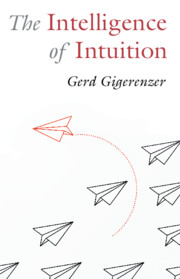Book contents
- The Intelligence of Intuition
- The Intelligence of Intuition
- Copyright page
- Dedication
- Contents
- Figures and Tables
- Preface
- Acknowledgments
- Chapter 1 We Know More Than We Can Tell
- Part I The War on Intuition
- Part II Intuition and Its Intelligence
- Chapter 5 Heuristics: The Tools of Intuition
- Chapter 6 Embodied Heuristics
- Chapter 7 Moral Intuition
- Chapter 8 Simple Heuristics to Run a Research Group
- References
- Index
Chapter 5 - Heuristics: The Tools of Intuition
from Part II - Intuition and Its Intelligence
Published online by Cambridge University Press: 28 September 2023
- The Intelligence of Intuition
- The Intelligence of Intuition
- Copyright page
- Dedication
- Contents
- Figures and Tables
- Preface
- Acknowledgments
- Chapter 1 We Know More Than We Can Tell
- Part I The War on Intuition
- Part II Intuition and Its Intelligence
- Chapter 5 Heuristics: The Tools of Intuition
- Chapter 6 Embodied Heuristics
- Chapter 7 Moral Intuition
- Chapter 8 Simple Heuristics to Run a Research Group
- References
- Index
Summary
To develop a scientific perspective on intuition, we first need to dispense with the old and misleading dualistic opposition of intuition and reason. Rather, intuition and reason go hand in hand: where a doctor feels that something is wrong with a patient, intuition comes first, followed by a deliberate search for what is wrong. Even abstract disciplines like mathematics, need both intuition and reasoning. As George Pólya emphasized, finding a problem or discovering a proof requires intuition and heuristics; checking whether the proof is correct requires logic and analysis. The theoretical framework to understand the nature of intuition is that of ecological rationality, the study of how mental processes are adapted to their environments, based on Herbert Simon’s notion of bounded rationality, i.e., how people make decisions under uncertainty – where the best action cannot be calculated. Good intuitions rely on adaptive heuristics that are not logically, but ecologically, rational. The fluency heuristic, the recognition heuristic, and satisficing exemplify tools of the adaptive toolbox. Under uncertainty, they can lead to better decisions than complex algorithms.
Keywords
- Type
- Chapter
- Information
- The Intelligence of Intuition , pp. 91 - 108Publisher: Cambridge University PressPrint publication year: 2023

